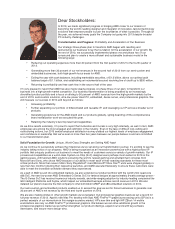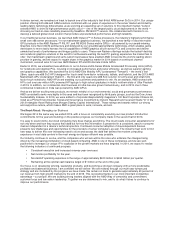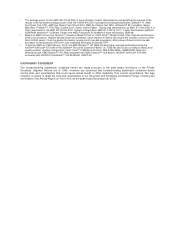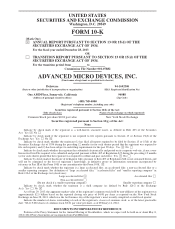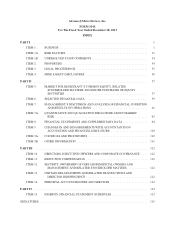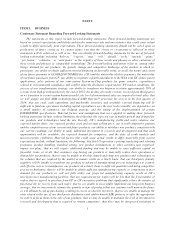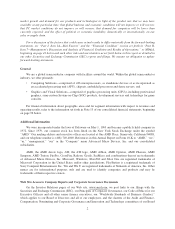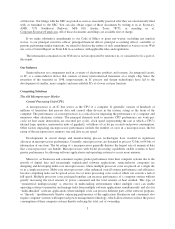AMD 2013 Annual Report Download - page 13
Download and view the complete annual report
Please find page 13 of the 2013 AMD annual report below. You can navigate through the pages in the report by either clicking on the pages listed below, or by using the keyword search tool below to find specific information within the annual report.Building on the integration of our CPU and GPU onto a single piece of silicon, we are focused on evolving
our accelerated computing architecture so that software programmers develop applications to more fully utilize
the full serial and parallel compute capabilities of our APUs. Heterogeneous Systems Architecture (HSA)
describes an industry standard that is an overarching design for having combinations of CPU and GPU processor
cores operate as a unified engine. We are a founding member of the HSA Foundation, a non-profit organization
established to define and promote this open standards-based approach to heterogeneous computing.
Desktop. Our APUs for desktop PC platforms consist primarily of the AMD A-Series and AMD E-Series
APUs. We also offer AMD FX CPUs for the enthusiast market. We designed the desktop AMD A-Series APU,
codenamed “Trinity,” for mainstream desktop platforms, and it is available primarily in quad- and dual-core
versions with a variety of discrete-level graphics configurations. In June 2013, we announced the 2013 Elite A-
Series APU, codenamed “Richland,” which offers improved performance and power efficiency compared to prior
AMD APUs. In January 2014, we began shipping the AMD A10-7850K and A10-7700K, codenamed “Kaveri,”
for desktops. “Kaveri” is the world’s first APU to include HSA features, AMD TrueAudio technology for
improved fidelity and immersive audio, and performing gaming experience of AMD’s Mantle application
programming interface, or API. Mantle allows game developers to more easily take advantage of the full
capability of our graphic core next architecture. The latest generation of AMD FX CPUs are based on the
“Piledriver” x86 multi-core architecture, are designed for multitasking, high resolution gaming and HD media
processing and come in eight-, six- and quad-core versions.
Notebook, Tablet, Hybrid. Consumers continue to demand thinner and lighter mobile platforms with
better entertainment performance and longer battery life. In response to this demand, we continue to invest in
designing and developing high performing and low power notebook platforms. Our notebook processors consist
primarily of performance AMD A-Series APUs, and AMD E-Series APUs. We designed the AMD A-Series
APU, codenamed “Trinity,” for mainstream and ultrathin notebooks, and we designed our AMD E-Series APUs
for mainstream notebooks. Our APUs for notebook platforms combine discrete-level AMD Radeon™ graphics,
dedicated HD video processing and multi-core CPU processors on a single die which are designed for maximum
performance and power efficiency. In March 2013, we launched our next generation 2013 AMD Elite
Performance A-Series APUs, codenamed “Richland,” designed to deliver innovative user experiences such as
facial log-in and gesture recognition for premium ultrathin, traditional and performance notebooks. In May 2013,
we launched our next generation 2013 AMD Mainstream quad-core x86 SOC, codenamed “Kabini,” designed for
entry-level and small-form factor touch notebooks, and the 2013 AMD Elite Mobility SOC, codenamed
“Temash,” our first 28nm, quad-core x86 SOC designed for small form-factor notebooks, tablets and hybrids 13
inches and below. We introduced the AMD Elite Quad-Core A4-1350 APU for tablets, hybrids and small-screen
touch notebooks in September 2013.
Server. A server is a system that performs services for connected customers as part of a client-server
architecture. Servers are designed to run an application or applications often for extended periods of time with
minimal human intervention. Examples of servers include web servers, e-mail servers and print servers. These
servers can run a variety of applications, including business intelligence, enterprise resource planning, customer
relationship management and advanced scientific or engineering models to solve advanced computational
problems in disciplines ranging from financial modeling to weather forecasting to oil and gas exploration.
Servers are also used in cloud computing, which is a computing model where data, applications and services are
delivered over the internet or an intranet.
Our microprocessors for server platforms consist of our AMD Opteron™ 6000, 4000, 3000 CPU and
X1150/X2150 APU series platform processors. In addition, to offering microprocessors for servers, we offer
dense server systems, designed to reduce power consumption and improve space efficiency for data centers. Our
dense server products include the SeaMicro SM15000™ server, as well as AMD’s SeaMicro Freedom™ Fabric
Storage series of storage enclosures. Our fabric technology, the SeaMicro Freedom™ supercompute fabric,
interconnects hundreds of card-sized motherboards and reduces the need for data networking equipment and
eliminates hundreds of cables, simplifying data center operations. We designed this fabric to reduce sever system
5


